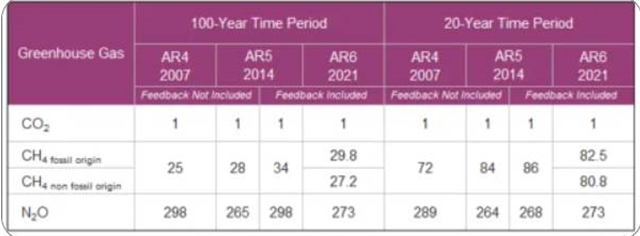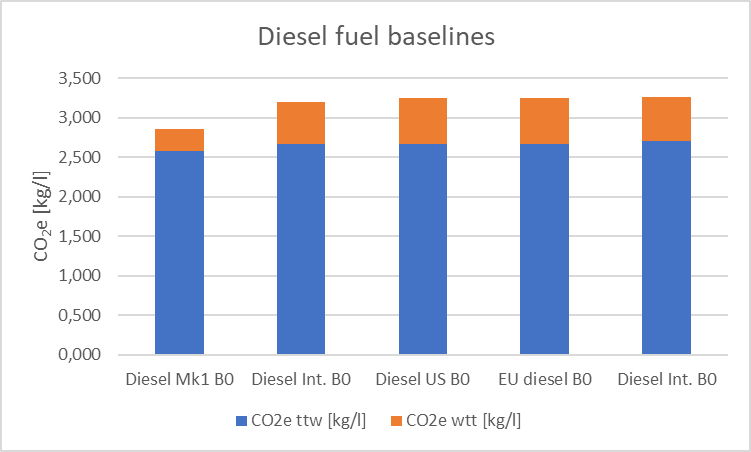NTM TN 13 Fossil diesel fuel baselines
Version: March 25, 2025
Summary
NTM continuously reviews various sources of life cycle assessment data (LCA) of diesel and other fuels. The aim is to ensure accurate and up to date baseline GHG-emission combustion in compression engines fuelled by fossil diesel The scope is primarily greenhouse gases, well to tank (wtt) and tank to wheel (ttw). In the ISO-standard 14 083 the wording is somewhat updated as described in below matrix.
The emissions from the propulsion (combustion) (ttw) are based on latest engine emission standard, where Euro 6 is used as a global proxy. IPCC GWP data according to AR 6 are used.
The result of the latest review of analysed fossil diesel resulted in:
- Nordic Mk1 diesel B0 updated ttw and wtt data
- International diesel B0 updated ttw and wtt data
Existing LCA studies indicate a substantial span of GHG emissions wtt from low to high. In a study in 2011 on the refineries in Sweden the average GHG emissions were 6,7 g/MJ. In the lates JRC-study, (Edwards et.al. version 5, 2020) the wtt-result was 18,9 for European diesel. The latter LCA is based on system expansion i.e., product substitution assuming marginal diesel production when calculating the impact of diesel production, thus resulting in significant higher CO2e per MJ fuel. These assessments can be considered as worst-case scenarios.
In order to provide a reasonable value NTM adjusted in 2022 previous international diesel assumption of 9,5 g/MJ according to LCA study Ahlvik & Eriksson by making a simple arithmetic average between the low 6,7 g/MJ and high 18,9 g/MJ i.e., 12,8 g/MJ rounded to 13 which also corresponds to the LCA-data in Gabi. In Gabi distribution is excluded, hence additional 10% is in this update added to the Mk1-diesel and international diesel.
Real performance is likely to deviate significantly in different markets. Hence more accurate calculations require operational and verified data from the fuel supplier. For MK1 B0 in Finland and Sweden NTM keep 6,7 g/MJ and adds 10% for distribution as this reflects existing refineries based on solid studies of these production processes. Below is an assessment of updated NTM-data and benchmarking data from Greet in the US, ISO 14 083 and previously data presented by EN 16 258.
NTM data (MK1 and Diesel Int.) is still based on LCA-studies averages on production, but a factor of 10% for transport is added. This is in line with the JRC study stating 13 g/MJ in international production. The ISO 14 083 assumes a higher energy content and higher density which leads to a higher total emission factor. For international diesel a fair assumption of CO2e is 3,2 kg/litre.
Diesel fuel baselines
Operation (ttw)
GHG ttw emissions are commonly calculated on the basic assumption of full oxidation of the carbon conte. Moreover, is a general assumption based on various diesel configurations that carbon weight content is on average 86%. For the light MK1 diesel the assumption is 85% due to lower density and its specific configuration. The general density of 0.832 kg/litre is used for all fuels even though there are differences from different sources and production processes. ISO 14 083 assumes 0.847 kg/litre.
Provision (WTT)
The wtt-data includes a huge span from lowest to highest numbers. Since production process is likely to improve the general data should over time decrease. This is however not visible in this set of data. In order to provide a reasonable value NTM have decided to adjust previous international diesel assumption of 9,5 g/MJ according to LCA study Ahlvik & Eriksson by making a simple arithmetic average between the low 6,7 g/MJ and high 18,9 g/MJ i.e., 12,8 g/MJ rounded to 13 which also corresponds to LCA-data in Gabi.
Other data
RED II and the Swedish Energy agency states GHG wtw for diesel fuels as below. Assuming the same ttw data for these fuels the wtt data ends up even higher than the highest number in table above. For the time being NTM has no explanation for this deviation but will further analyse the issue.
NTM general methodology and scope
NTM provides emission and energy data for all modes of traffic through the tool NTMCalc and the web page www.transportmeasures.org. Data are based on various fossil and biogenic sourced fuels. Electricity data is based on fossil and biogenic sources as well as electric power from hydro, wind, photovoltaic and nuclear. In order to determine the gains from the use of various new fuels and electricity, there is a need to present credible baseline data for existing solutions being replaced. Comparisons are not easy, as system boundaries differ between the solutions compared i.e., sometimes resulting in arbitrary results. For the time being NTM aims to include a well-to-wheel perspective according to dotted blue figure below.
NTM present system boundary
The environmental effects from the production and use of fuels and electricity can be assessed through the Life Cycle Assessment (LCA) methodology. There are two methodological approaches in LCA namely the consequential (CLCA) and attributional (ALCA) approach. These two approaches vary in scope while the choice between ALCA and CLCA guides other methodological decisions, such as the choice of input data and the modelling of processes with multiple products (Ekvall, 2019). CLCA, also called “change oriented” uses marginal data aiming to “describe how the environmental exchanges of the system can be expected to change as a result of actions taken in the system” (Rebitzer et al., 2004). The second approach (attributional or accounting) “describe a product system and its environmental exchanges” by using average data, and data that “reflect the actual physical flows to and from the studied system” (Finnveden et al., 2009).
In multioutput processes i.e., process that result in more than one product (than the product under assessment), the attributional approach allocates the emissions among the different outputs based on physical or other relationships while in the consequential approach the system is often expanded to include additional systems or processes (second order effects). NTM uses the attributional principle when emission factors are estimated and reported.
References
Ahlvik, P., Eriksson, L. (2011) Well to tank assessment – diesel fuel MK1 and EN 590, Report 127057, rev. 2, Ecotraffic.
Eriksson M., Ahlgren, S. (2013) LCAs for petrol and diesel – a literature review. Report 2013:058. SLU, Swedish University of Agricultural Science.
European Commission. (2018). DIRECTIVE (EU) 2018/2001 OF THE EUROPEAN PARLIAMENT AND OF THE COUNCIL of 11 December 2018 on the promotion of the use of energy from renewable sources. Official Journal of the European Union. L 328/82
Gode J, et. Al., (2011) Miljöfaktaboken 2011. Estimated emission factors for fuels, electricity, heat and transport in Sweden. VÄRMEFORSK Service AB. Available at https://energiforskmedia.blob.core.windows.net/media/17907/miljoefaktaboken-2011-vaermeforskrapport-1183.pdf
Network for Transport Measures: www.transportmeasures.org
JRC: https://ec.europa.eu/jrc/en
Swedish Energy Agency: https://www.energimyndigheten.se/en/
GREET model published 2018 by Argonne National Laboratory: https://greet.es.anl.gov/
SS-EN ISO 14 083:2023
Published
Present: March 25 2025
Previous: October 22, 2021









